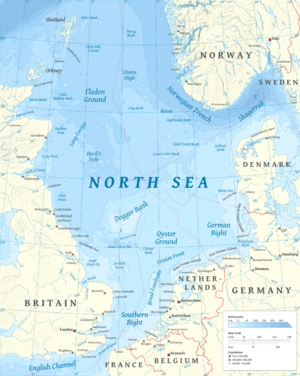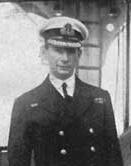First Ostend Raid facts for kids
Quick facts for kids First Ostend Raid |
|||||||
|---|---|---|---|---|---|---|---|
| Part of North Sea Operations, First World War | |||||||
 North Sea |
|||||||
|
|||||||
| Belligerents | |||||||
| Commanders and leaders | |||||||
|
|
|||||||
| Strength | |||||||
| see British order of battle below | Shore defences | ||||||
| Casualties and losses | |||||||
| Unknown | Unknown, negligible | ||||||
The First Ostend Raid was a daring attack by the Royal Navy during World War I in April 1918. Its main goal was to block the important German-held port of Ostend in Belgium. This raid happened at the same time as a bigger attack on the nearby port of Zeebrugge.
The British wanted to stop German ships, especially U-boats (submarines), from leaving the port of Bruges. Bruges was about 10 kilometers (6 miles) inland. It was a perfect base for German U-boats to attack Allied ships and supply routes. These U-boats were causing big problems for Britain, especially in the English Channel and the Western Approaches, which were busy shipping lanes.
The plan was to sink old ships, called "blockships," in the narrow canal entrances at Ostend and Zeebrugge. This would trap the German ships inside Bruges. While the Zeebrugge attack had some success, the First Ostend Raid did not go as planned. The German defenders were ready and tricked the British ships, leading to the mission's failure. A few weeks later, a second attack was launched, which was a bit more successful but still didn't completely close off Bruges.
Contents
Why Bruges Was Important
Bruges was captured by German forces early in World War I. The Imperial German Navy quickly saw how useful it was. Bruges was located inland, connected to the sea by canals at Zeebrugge and Ostend. This inland position made it safe from most attacks by land or sea.
The German Navy built large training and repair facilities in Bruges. These supported many destroyers, torpedo boats, and U-boats. By 1916, these German ships were a serious threat to British shipping. Bruges was very close to the British coast and important shipping lanes.
The British Admiralty (the British Navy's command) was very worried. In 1915, Admiral Reginald Bacon tried to destroy the lock gates at Ostend, but he failed. As the war went on, the U-boat threat grew. By early 1918, the Admiralty looked for new ways to stop the U-boats. They created a new department called "Allied Naval and Marine Forces."
This new department was set up to plan and carry out raids along the German-held coast. It had many ships and resources from both the British and French navies. Admiral Roger Keyes and his deputy, Commodore Hubert Lynes, led this group. They started planning how to block Bruges in late 1917. By April 1918, their plans were ready.
Planning the Attack
To block Bruges, Admiral Keyes and Commodore Lynes decided on two raids. The larger raid would target Zeebrugge. A smaller force, led by Lynes, would attack Ostend.
For Ostend, the plan was to use two old cruisers, HMS Sirius and Brilliant, as blockships. These ships were stripped down and filled with rubble and concrete. This would make them heavy and perfect for blocking the canal if sunk in the right spot.
The attack was planned for night, to happen just after midnight. It would be timed with the Zeebrugge Raid. This way, the German defenders would be stretched thin and surprised. British warships, called monitors, would fire on German defenses from offshore. Artillery from Royal Marines near Ypres would also provide support.
Closer to the action, small boats like motor launches, torpedo boats, and Coastal Motor Boats would help. They would create smoke screens to hide the blockships. They would also rescue the crews of the cruisers after the ships were sunk.
British Ships and Forces
The British force was divided into two main groups.
Offshore Squadron
This group provided heavy gunfire support from a distance.
- Monitors (ships with very large guns):
- HMS Marshal Soult
- Lord Clive
- Prince Eugene
- General Crauford
- HMS M24
- M26
- M21
- Destroyers (fast warships):
- HMS Mentor
- Lightfoot
- Zubian
- French Navy Mécanicien Principal Lestin
- French Navy Enseigne Roux
- French Navy Bouclier
- Light craft:
- 4 torpedo boats
- 4 French motor launches
Inshore Squadron
This group carried out the main blocking mission.
- Blockships:
- HMS Sirius
- Brilliant
- Destroyers:
- HMS Swift
- Faulknor (leader)
- Matchless
- Mastiff
- Afridi
- Tempest
- Tetrarch
- Light craft:
- 18 Motor Launches
- 8 Coastal Motor Boats
Heavy artillery from the Royal Marines also helped from Allied-held areas. Seven light cruisers and 16 destroyers covered the force in the English Channel, but they did not take part in the fighting.
The Attack on Ostend
The attacks on Zeebrugge and Ostend began on April 23, 1918. The Ostend force arrived just before midnight. The monitors took their positions offshore and began firing on German defenses. These included powerful 280 mm (11 inch) guns from the "Tirpitz" battery.
As the long-range gunfight started, the blockships moved towards the harbor mouth. They were looking for special marker buoys. These buoys showed the safe path through the many sandbanks along the Belgian coast.
This is where the attack went wrong. Strong winds blew the smoke screen back into the faces of the advancing cruisers. This blinded their commanders. The same wind also revealed the British ships to the German defenders. The Germans immediately opened heavy fire on the blockships.
The volunteer crews on the blockships suffered many casualties. Despite poor visibility, the commanders sped up, trying to find the "Stroom Bank buoy." This buoy guided ships into the canal.
Commander Alfred Godsal led the attack in Brilliant. His ship was the first to run into the German trap. As Brilliant moved through the darkness, a lookout spotted the buoy. Godsal steered directly for it, even as heavy fire hit his ship. After passing the buoy, Brilliant suddenly stopped with a jolt. It was stuck fast in deep mud, far from the harbor entrance.
Before warnings could reach HMS Sirius, which was following close behind, it also passed the buoy. Its captain, Lieutenant-Commander Henry Hardy, was shocked to see Brilliant directly ahead. With no time to turn, Sirius crashed into the side of Brilliant. Both blockships were now stuck in the mud, tangled together and useless.
German artillery and machine gun fire continued to hit the stuck ships. The crews were ordered to evacuate. Officers set charges to sink the blockships where they were. Men climbed down into Coastal Motor Boats, which took them to the Offshore Squadron. Destroyers moved closer to Ostend to protect the retreat. The monitors kept up their heavy firing. Godsal was the last to leave, rescued by a small boat. With the main attack a complete failure, the British forces returned to Dover and Dunkirk.
| "Their Lordships will share our disappointment at the defeat of our plans by the legitimate ruse of the enemy." |
| Admiral Keyes' report to the Admiralty. |
When the commanders met, they understood what had happened. The German commander at Ostend was very well prepared. He knew that without the navigation buoy, a night attack would be impossible for the British. Instead of just removing the buoy, he had it moved about 2,200 meters (2,400 yards) east of the canal mouth. It was placed in the middle of wide sandbanks. This acted as a deadly trick, leading the British ships astray.
Aftermath of the Raid
The attack at Zeebrugge was more successful. Blocking that main channel did cause some problems for the Germans in Bruges. Larger German ships could no longer leave the port. However, smaller ships, including most submarines, could still use the Ostend canal. Also, within hours, the Germans had cleared a narrow path through Zeebrugge, though the British didn't know this for weeks.
The failure at Ostend didn't completely ruin the excitement in the British media and public about the Zeebrugge raid. But for the Admiralty and the "Allied Naval and Marine Forces," the failure to completely block Bruges was frustrating.
A second operation was planned for May 10, using the cruiser HMS Vindictive. This attack was more successful, but it still didn't completely close off Bruges. A third planned operation was never carried out. It became clear that the new channel at Zeebrugge was enough for U-boats to get through. This would have required an even bigger attack, which the Allied forces didn't have enough resources for.
The three attempts to close Bruges cost the British over 600 casualties and several ships. Bruges remained an active base for the German Navy until October 1918, when Allied land forces finally liberated the town.
Images for kids



